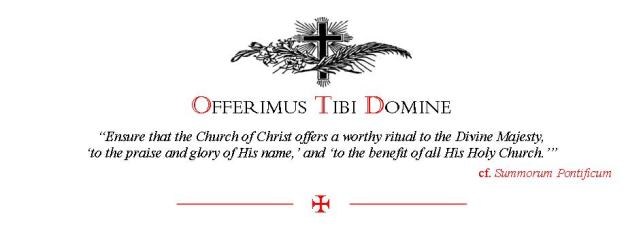On Saturday 31st May I assisted as Sub deacon at High Mass in the beautiful church of Our Lady and St Wilfrid at Warwick Bridge just outside Carlisle, as a guest of the Parish that looks after the chapel, Canon John Watson of Our Lady and St Joseph in Carlisle itself. The priests there have been recently established by Bishop Campbell as Canons of Ss Ambrose and St Charles, as a place of support and fellowship for priests. Bishop Campbell was in attendance at the Mass itself - no mean feat in the tiny sanctuary! Fr John Millar, assistant at the parish acted as Deacon and we were marshalled by Mr George Steven as the MC.
The occasion was organised to celebrate the Feast of St Petronia, who relics rest in the chapel. The body of St Petronia was discovered in the catacombs of Priscilla in rome in 1841. She was found buried with a phial of blood (now turned to dust) - something commonly done when the deceased had been martyred for the Faith. The stone name-plate from her tomb was also excavated. By order of Pope Gregory XVI it was decreed that Petronia should be venerated as a Virgin Martyr.
The relics appear to have been given to Marmeduke Constable-Maxwell (the 11th Lord Herries of Terregles (1837–1908) - possibly by Servant of God, Raphael Cardinal Merry del Val. The familly then transferred them to the domestic chapel at their home, Terregles in Dumfries. In the late nineteenth century his descendants married into the Howard family at Corby Castle. The relics were definitely at Corby by 1919 when the parish priest, Fr John Cody, OSB, carried out an investigation upon them. The relics were then transferred to Benedictine Sisters at Holme Eden Abbey. When the Abbey closed in 1983, they were given to the church at Warwick Bridge.
On 25th September 1940 Thomas Edward Flynn, the second bishop of Lancaster, opened the reliquary to examine its contents. He removed three small bones to be placed in separate reliquaries, the whereabouts of which are not now known. The reliquary was then resealed. In 1991 Mgr Gregory Turner, Vicar General of the Diocese, carried out a further investigation. It was estimated that she was a girl of about ten years old.
Canon Watson wore a chasuble belonging to the parish, the orphrey of which was stitched by Mary Queen of Scots. (Ben Trovato attended the Mass and has posted another photo of the chasuble & a few more details on his site).
The church's loveliness is accounted for by the fact that it was designed by Augustus Welby Northmore Pugin, completed in 1841 for a sum total of £2,586. The church was designed for the Sarum Rite, and contains an Easter Sepulchre. (Now the usual home for the relics.)
The designs were originally commissioned by Henry Howard of nearby Corby Castle, and included plans for a presbytery and grounds, which are now in use by the parish.
The tiny pulpit and a detail from the front showing St Paul preaching "Christ crucified."
Mass was followed by a procession around the picturesque grounds with the relics of St Petronilla.


















3 comments:
I'm curious, Fr., are all the Masses there eastward facing? I see no table altar!
I used to live in the area and attended regularly. The church was, I think, endowed by a local family. Upon the emergence of the NOM, it was discovered that they had to Celebrate a TLM once a year. One PP did not want it to be widely broadcast as he feared it would become a centre for dissent - I kid you not. That priest was however a kindly and diligent sould - a Benedictine. There was once a rumour that some people wanted to re-order the Church? Canon Watson is a great priest.
Beautiful church and a chasuble with orphrey stitched by Mary Queen of Scots no less, wow. Lovely to read new Canons have been established and I think its good that the merged parishes are now under a new name, Our Lady of Eden. Is there a statue or shrine to Our Lady of Eden? Is it a new title for Our Lady that Bishop Campbell made up? Lovely title.
"He removed three small bones to be placed in separate reliquaries, the whereabouts of which are not now known."
- Such a pity. Perhaps with St Petronilla's intercession, the relics can be found...
Post a Comment